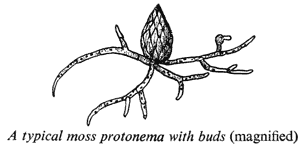
Protonema is found in lifecycle of
A. Spirogyra
B. Rhizopus
C. Funaria
D. Dryopteris
Answer
502.8k+ views
Hint: A protonema is a thread-like chain of cells that forms the earliest stage of the life cycle of mosses.
Complete answer:
Protonema can be seen in Funaria as it is a type of moss.
Funaria are primitive multicellular, autotrophic, shade loving, amphibious moss. They reproduce by spore formation. They have no vascular system. Root like structures called rhizoids are present. They show alternation of generation i.e. the gametophytic stage alternates with the sporophyte stage. When it grows from the spore, it starts as a germinate tube that lengthens and branches off to form filamentous form called protonema. The protonema starts as a colourless tube filled with the chlorophyll containing cells called chloronemata which later mature into cells called caulonemata which have reddish brown pigmented cell walls. The protonema then develops into a leafy gametophore, the adult form of Funaria, which is its more common form. The protonema stage takes part in the haploid phase of the moss.

So, The correct option is C ‘Funaria’.
Note: In most mosses the protonema is filamentous but in a few genera, it is thalloid. In some, there is a short, filamentous chloronemata but it soon develops into a thallose form. The thallose area, through composed of many cells, is only one cell thick. And in others, the spores of moss have thick walls and the spore divides within the spore wall leading to the existence of two cells within the stretched spore wall which ruptures after growing and leads to the development of a protonemal component consisting of between 20 and 25 globose cells. This is called a massive protonema.
Complete answer:
Protonema can be seen in Funaria as it is a type of moss.
Funaria are primitive multicellular, autotrophic, shade loving, amphibious moss. They reproduce by spore formation. They have no vascular system. Root like structures called rhizoids are present. They show alternation of generation i.e. the gametophytic stage alternates with the sporophyte stage. When it grows from the spore, it starts as a germinate tube that lengthens and branches off to form filamentous form called protonema. The protonema starts as a colourless tube filled with the chlorophyll containing cells called chloronemata which later mature into cells called caulonemata which have reddish brown pigmented cell walls. The protonema then develops into a leafy gametophore, the adult form of Funaria, which is its more common form. The protonema stage takes part in the haploid phase of the moss.

So, The correct option is C ‘Funaria’.
Note: In most mosses the protonema is filamentous but in a few genera, it is thalloid. In some, there is a short, filamentous chloronemata but it soon develops into a thallose form. The thallose area, through composed of many cells, is only one cell thick. And in others, the spores of moss have thick walls and the spore divides within the spore wall leading to the existence of two cells within the stretched spore wall which ruptures after growing and leads to the development of a protonemal component consisting of between 20 and 25 globose cells. This is called a massive protonema.
Recently Updated Pages
Master Class 11 Economics: Engaging Questions & Answers for Success

Master Class 11 Business Studies: Engaging Questions & Answers for Success

Master Class 11 Accountancy: Engaging Questions & Answers for Success

Master Class 11 English: Engaging Questions & Answers for Success

Master Class 11 Computer Science: Engaging Questions & Answers for Success

Master Class 11 Maths: Engaging Questions & Answers for Success

Trending doubts
State and prove Bernoullis theorem class 11 physics CBSE

1 ton equals to A 100 kg B 1000 kg C 10 kg D 10000 class 11 physics CBSE

State the laws of reflection of light

One Metric ton is equal to kg A 10000 B 1000 C 100 class 11 physics CBSE

1 Quintal is equal to a 110 kg b 10 kg c 100kg d 1000 class 11 physics CBSE

Difference Between Prokaryotic Cells and Eukaryotic Cells




